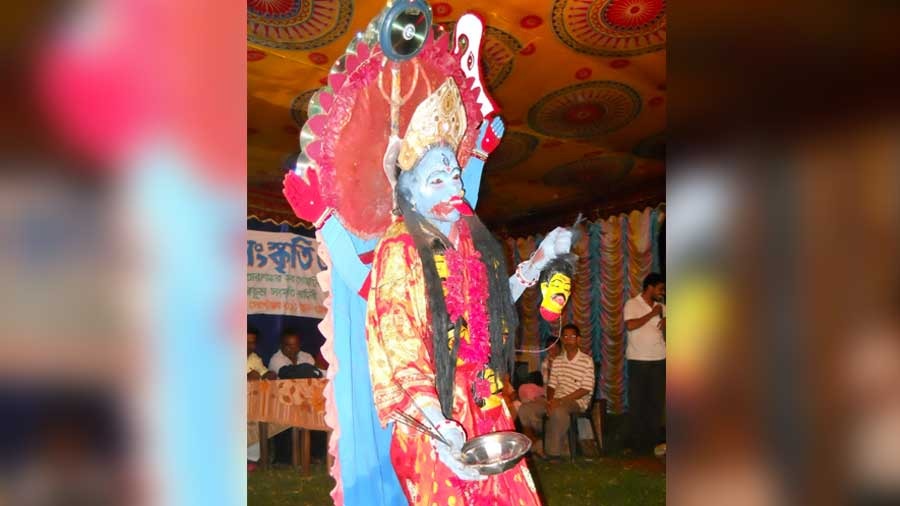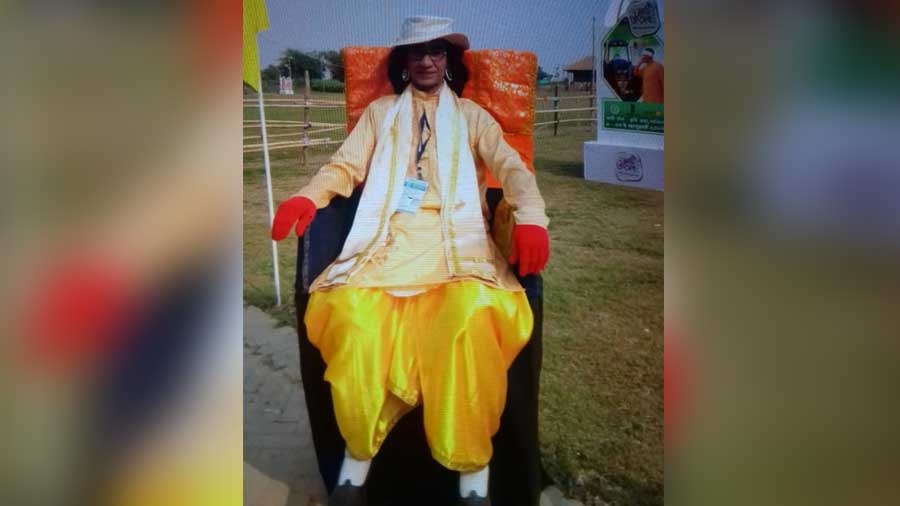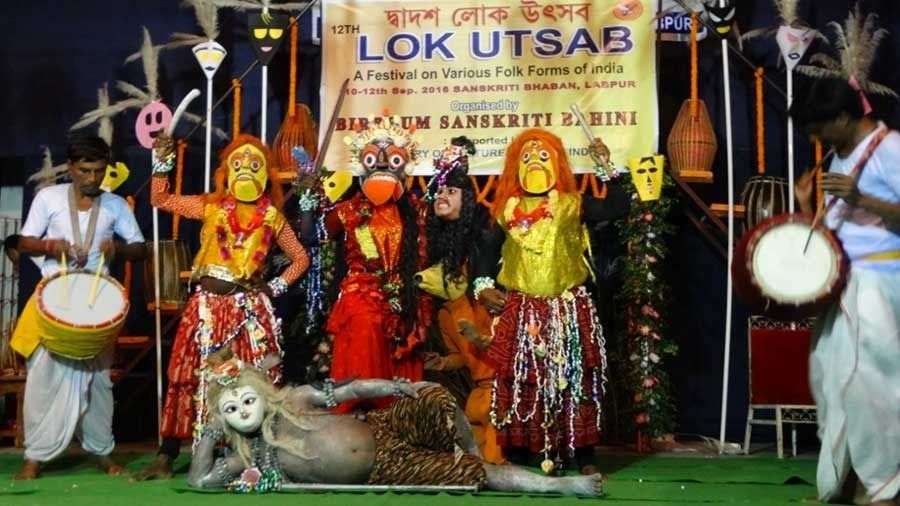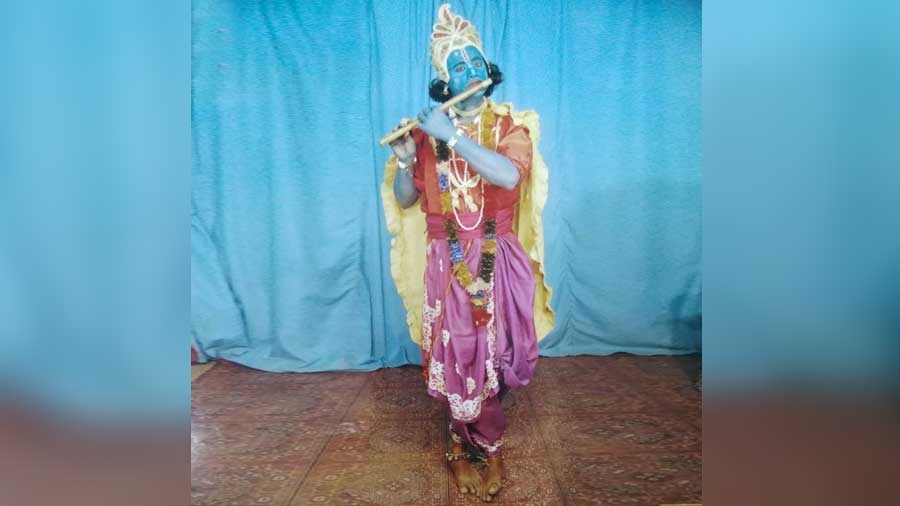Located in the Labhpur tehsil of Birbhum is a small village named Bishoypur, also known as the Bohurupi gram. Years ago, some hunters, mostly with the Byadh surname, started residing in this area. They started dressing up as mythological characters and went from home to home and from one para to the another to showcase their act and came to be popularly known as Bohurupis.
According to some, the idea of Bohurupis emerged from the Ramayana and Mahabharata, where at different time, characters could change their forms. For example, in the Ramayana, the demon Marich transforms into a ‘sonar hareen’ (a golden deer).
There could be one more possibility, says Ujjal Mukhopadhyay, a dramatist and a researcher on Birbhum’s folk culture. He says that since the Byadhs were mostly hunters, they already had the idea of dressing up like others as a way of camouflage. This, in a way, may have given birth to this performing art.

Bishoypur is a hub for Bohurupis, who are mostly nomadic by nature Courtesy: Birbhum Sanskriti Bahini
Bishoypur is the hub for Bohurupis, who are mostly nomadic by nature. Though they can be found scattered in different parts of Bengal due to their nomadic lifestyle, Bishoypur houses the majority. The village is so crowded that some people live under tarpaulin tents. Since hunting is prohibited, now their livelihood solely depends on this profession.
Bohurupis usually go to each house of a locality for a period of seven days, donning seven different avatars. On the last day, they all dress up as Gowalini for the collection of donations.

A Bohurupi dressed as Ma Kali Courtesy: Birbhum Sanskriti Bahini
They usually perform their acts in winter and during the Bengali month of Bhadra. However, due to financial crunches and for a quick show, the seven-day show has been squeezed to a one-day act for many.
Though this artform is slowly dying, with recent undertakings by the government and some local theatre groups, a ray of hope has entered their lives. Theatre groups have engaged with them on the stage, while the government often use their services to spread social awareness messages. For example, in 2020, to spread the message of Covid awareness, a lot of Bohurupis were engaged by the Birbhum police.

Bohurupis engaged by the Birbhum police to spread the message of Covid awareness Courtesy: Labhpur PS
According to Ujjal Mukhopadhyay, “Street drama can be called an extension of this. The Bohurupis are the pioneers of this. Not only do they dress up as different characters, they act like them too. Each is distinctly different from the other. Be it body language or voice modulation, everything is very distinct. All of them are great artistes.”
One of the veterans in this art form is Uttam Kumar Mondal, who has been doing this for 45 years. He learnt this artform from his father. Though this is not his family tradition, Mondal has taught his son the same, though he has not taken it up professionally yet.

Uttam Kumar Mondal has been a Bohurupi for 45 years
According to Mondal, times have changed as people have access to many other entertainment platforms. However, with the support of the government and some local groups, they remain hopeful. The previous generations did not get this exposure. And the government aid is of huge help to the community, since the meagre income they earn from their profession is hardly enough.
“There was a time when this artform was on the road to extinction, but now some hope has come to our lives,” said Mondal. Now, Bohurupis are even invited to cultural programmes and festivals. “We are called for government programmes where we dress up to deliver some social message. Now not only in our nearby localities, we perform in far-off places too. Previously, this was not possible as communication was a major concern.

Bohurupis perform at a cultural programme Courtesy: Birbhum Sanskriti Bahini
Mondal usually dresses up as Krishna, Kali, Vishnu, Radha, Gowalini, Durga, Mahishashur and others for a show. Time to dress up depends on the character he chooses. It may vary from half an hour to two hours.
Mondal makes the costumes himself to cut short his expenses. For make-up, not only Mondal, but all the Bohurupis use the local Dishi powder brand. They use different colours too. One of the most popular characters that Mondal plays to spread social awareness is ‘Hothat Babu’.
Another veteran artiste of the village is Sukumar Chowdhury. According to Chowdhury, Bohurupis should be able to act well, along with the requisite attire and make-up.

Veteran artiste Sukumar Chowdhury dressed up as Lord Krishna
Dialogue plays a very important role in their acts. The words must come out spontaneously. The way they speak is important. Chowdhury dresses up in different characters like Ram, Krishna, Mahishashur, dacoits and others. He also dresses up as different characters to raise social awareness.
He believes that whatever character a Bohurupi plays, it should entertain the audience. He too learnt the artform from his father, Dukkhoron Chowdhury. His entire family was involved in the art once. But his daughter, who is a postgraduate, has taken up a job and his son, though trained in the artform, has not yet taken it up professionally.
